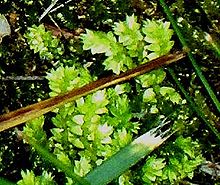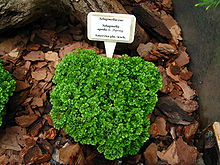- Selaginella apoda
-
Meadow spikemoss 
Conservation status Scientific classification Kingdom: Plantae Division: Lycopodiophyta Class: Isoetopsida Order: Selaginellales Family: Selaginellaceae Genus: Selaginella Species: S. apoda Binomial name Selaginella apoda
(L.) Spring[2]Synonyms Diplostachyum apodum
(L.) P.Beauv.
Lycopodioides apoda (L.) Kuntze
Lycopodium albidulum Sw.
Lycopodium apodum L.
(basionym)
Selaginella albidula (Sw.) Spring- List sources : [3]
Selaginella apoda, commonly known as meadow spike-moss, is a lycophyte native to much of the eastern United States and parts of northeastern Mexico. It is found primarily in damp soils in habitats such as swamps, wet fields, open woods and along stream banks. A lowland plant, it has only been recorded at elevations below 100 metres. It is closely related to Selaginella eclipes and S. ludoviciana, both of with which it has been reported to form hybrids. This group is characterised by relatively flat strobili and large megasporophylls which occur in the same plane as the lateral leaves.[4]
The plant was originally described, and named Lycopodium apodum by Carl Linnaeus in his Species Plantarum (1753).[2]
References
- ^ "Selaginella apoda". NatureServe Explorer. NatureServe. http://www.natureserve.org/explorer/servlet/NatureServe?searchName=Selaginella+apoda+. Retrieved 2008-01-28.
- ^ a b In: Flora Brasiliensis 1(2): 119. 1840. [as Selaginella "apus" ] "Name - !Selaginella apoda (L.) Spring". Tropicos. Saint Louis, Missouri: Missouri Botanical Garden. http://www.tropicos.org/Name/26602856. Retrieved March 29, 2010.
- ^ "Name - !Selaginella apoda (L.) Spring synonyms". Tropicos. Saint Louis, Missouri: Missouri Botanical Garden. http://www.tropicos.org/NameSynonyms.aspx?nameid=26602856. Retrieved March 29, 2010.
- ^ Valdespino, Iván A. (1993). "Selaginella apoda". In Flora of North America Editorial Committee, eds. 1993+. Flora of North America. 2. New York & Oxford: Oxford University Press. http://www.efloras.org/florataxon.aspx?flora_id=1&taxon_id=200002770
External links
- Profile at USDA PLANTS Database
- Range Map from Flora of North America
- Illustration from Flora of North America
This lycophyte-related article is a stub. You can help Wikipedia by expanding it.


